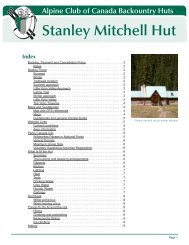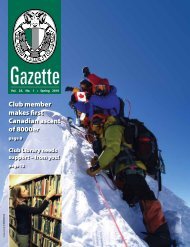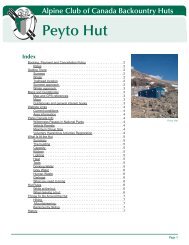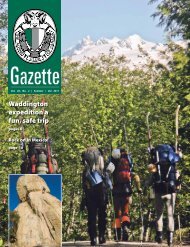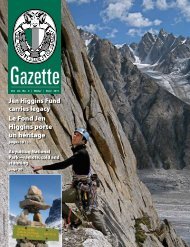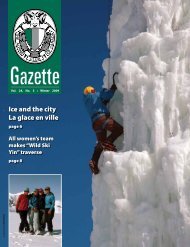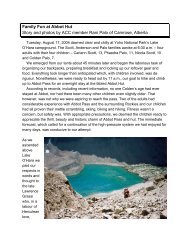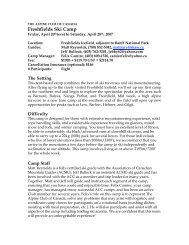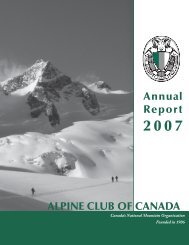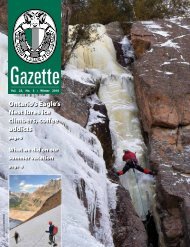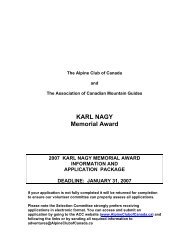Summer 2007 - The Alpine Club of Canada
Summer 2007 - The Alpine Club of Canada
Summer 2007 - The Alpine Club of Canada
Create successful ePaper yourself
Turn your PDF publications into a flip-book with our unique Google optimized e-Paper software.
Glaciers shaped by weather, gravity and setting<br />
BY PABLO WAINSTEIN<br />
As climbers, skiers and lovers <strong>of</strong><br />
the outdoors we are constantly<br />
amazed by the mountain<br />
landscape that forms our playground. Our<br />
photo archives are stuff ed with pictures<br />
<strong>of</strong> glaciers and the landscapes that have<br />
been shaped by ice throughout thousands<br />
<strong>of</strong> years. Rock walls, open wide valleys,<br />
moraines and glaciers are all linked by<br />
a common geological history <strong>of</strong> ever<br />
changing features driven by slow but<br />
incredibly big forces.<br />
Glaciers are active systems that<br />
live in a subtle equilibrium with the<br />
surrounding environment. Th ey grow and<br />
shrink; advance and retreat, all delicately<br />
governed by a mass balance between what<br />
they receive as snow intake, what they<br />
expel as meltwater, and by sublimation<br />
(the conversion between the solid and the<br />
gas phases with no intermediate liquid<br />
stage).<br />
Th e main mass inputs are achieved<br />
through precipitation as snow and rain<br />
that can refreeze in the glacier’s interior,<br />
and from avalanching from affl uent<br />
valleys. Th e main output by far is melting<br />
and is presented as meltwater. Secondary<br />
processes such as calving and ice<br />
avalanching also play major roles. Calving<br />
is the process by which ice slabs are down<br />
wasted into the water if the glacier ends<br />
Would you like to receive easy tips on how you can help the environment?<br />
ACC NewsNet subscribers get the tips.<br />
To subscribe, email: NewsNet@<strong>Alpine</strong><strong>Club</strong><strong>of</strong><strong>Canada</strong>.ca<br />
28 <strong>Alpine</strong> <strong>Club</strong> <strong>of</strong> <strong>Canada</strong> ● Gazette ● SUMMER <strong>2007</strong><br />
in a lake or the sea. On the contrary, if the<br />
glacier ends in dry land – as the majority<br />
<strong>of</strong> alpine glaciers do – the process is<br />
called ice avalanching. Th e latter is<br />
slightly less frequent since there is no<br />
water to exert buoyancy pressures under<br />
the ice and fracture it. Unfortunately,<br />
terminology is sometimes confusing but<br />
its goal is to be as descriptive as possible.<br />
Website shares <strong>Canada</strong>-wide trail and route info<br />
Do you know <strong>of</strong> a great trail – so great you’d want to share it?<br />
Trailpeak.com is a user driven website featuring information on over<br />
3000 trails, routes and destination for hikers, mountain bikers, climbers,<br />
backcountry and cross country skiers, snowshoers, kayakers, canoeists and even kite<br />
and windsurfers.<br />
Th e <strong>Canada</strong>-wide site provides information from Vancouver Island to<br />
Newfoundland, complete with topo maps, links to GPS coordinates, satellite imagery<br />
and local weather forecasts.<br />
It also shares user submitted reviews on Google Earth, gear, routes and trails, plus<br />
user blogs and feature articles on adventure destinations. And it <strong>of</strong>f ers an outdoor<br />
navigation course.<br />
Route and trail info can be searched by activity, diffi culty or by province, location<br />
or region, and include distances and diffi culty ratings - all aimed at providing users<br />
with comprehensive information for their outdoor activities.<br />
To learn more, check out www.trailpeak.com<br />
Even though we see many iced areas<br />
in the mountains, not all can be called<br />
glaciers. Glaciers are made out <strong>of</strong> ice that<br />
experience movement and deformation.<br />
As such, they require a minimum size and<br />
depth that will promote movement due<br />
to the action <strong>of</strong> gravity.<br />
Glaciers have two recognizable areas<br />
that are fundamental for their survival: an<br />
accumulation zone and an ablation zone.<br />
Th e two are separated by what is called<br />
the ‘equilibrium line’. Th e accumulation<br />
area is where snow falls and fortunately<br />
is preserved throughout the year, adding<br />
mass to the glacier. Th e ablation area is<br />
where there is more melting than mass<br />
infl ow. Both need to be in equilibrium<br />
in order for the glacier to maintain a<br />
constant size. Nowadays many glaciers<br />
present a considerable meltdown due<br />
to warmer/drier winters that suppresses<br />
precipitation, and/or warmer summers<br />
that incite a larger meltdown. Th ere are<br />
some exceptions, such as Taku Glacier<br />
in the Juneau Icefi eld in Alaska, which is<br />
still growing mainly as a result <strong>of</strong> its huge<br />
accumulation area and its large inertia,<br />
but these are just that – exceptions to the<br />
rule.<br />
<strong>Alpine</strong> <strong>Club</strong> <strong>of</strong> <strong>Canada</strong> member Pablo<br />
Wainstein is a hydraulic civil engineer<br />
and PhD student with the University <strong>of</strong><br />
Calgary’s Department <strong>of</strong> Geography.



